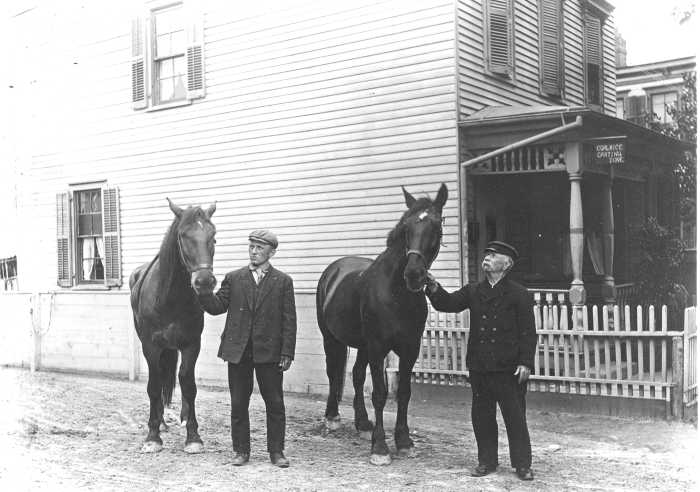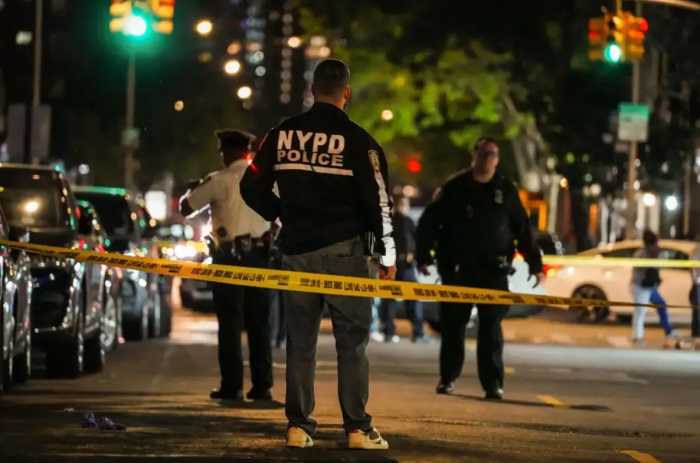By Helen Klein
The geographical center of Brooklyn, Flatbush in 2006 was also a community at the center of change. Across this densely packed neighborhood, one of the most ethnically diverse in the city, grand scale alterations have been taking place, sometimes at a dizzying pace. Mall Underway Early in the year, after many years of waiting, ground was broken on a new mall for the Junction area. Being built on the site of the old municipal parking lot, nestled between Flatbush Avenue, Avenue H, Nostrand Avenue and the Long Island Railroad tracks, the three-story, 300,000-square-foot retail complex, Triangle at the Junction, will have Target as its anchor store, and is expected to debut in early 2008. Successful Bid Nor is the mall the only change on tap for the Junction. In April, the City Council voted in favor of establishing a Business Improvement District for the shopping hub, in an area an area generally delineated by Flatbush Avenue between Farragut Road and East 32nd Street, Nostrand Avenue between Glenwood Road and the Long Island Railroad cut, Hillel Place and the Brooklyn College campus as far as Bedford Avenue. The BID is a public-private partnership in which merchants and property owners assess themselves to pay for amenities including supplemental sanitation services, security guards, promotion of the area and holiday lighting. Its formation also opens the door for a $4.5 million streetscape improvement project, funded years ago through the City Council, but held in abeyance because of the lack of any organization that could maintain the fixtures included in it. Rebirth for Kings? Other changes are also in the works for the Flatbush Avenue commercial corridor. Toward the end of 2006, the city began an effort to market the long-empty Loews Kings theater to a developer. This effort was applauded by community activists as the site, at the heart of a vibrant shopping district, has been a blight, rather than an asset for many years. While the future of the Kings is still clouded, the city’s Economic Development Corporation is looking for a proposal that would utilize the site while restoring and keeping intact many of its distinctive features. The hope, according to Borough President Marty Markowitz, is that a revitalized Kings theater can fill a void in the borough – providing a grand gathering space for entertainment and other public events. Need to Down-zone While the Junction development and the possible redevelopment of the Loews Kings bring positive energy to the community, not all development is greeted enthusiastically by residents. Like much of Brooklyn, Flatbush has been under assault by developers, who are tearing down the area’s spacious one and two-family homes and putting up multi-family condominiums in their stead. Because of this, there are movements afoot in different corners of the community, to have the neighborhood down-zoned, working through the community boards (CB 14 and CB 17), elected officials and the key municipal agency, the Department of City Planning. Of particular concern are areas where the built environment is low-rise and low-density, but the underlying zoning allows for apartment buildings. Endangered Areas These includes sections of East Flatbush, such as including the area which is bordered, generally, by Lenox Road, Brooklyn Avenue, Avenue H and Bedford Avenue, and the area bordered by East New York Avenue, East 98th Street, Linden Boulevard and East 51st Street. Also in jeopardy are areas of what is known collectively as Victorian Flatbush, including Ditmas Park West, Beverley Square West, Beverley Square East and South Midwood. While the mismatch between the existing buildings and the underlying zoning is what makes these areas vulnerable, their vulnerability is increased because the existing structures are free-standing, and because they are built on relatively large lots, which can accommodate larger buildings. Landing Landmark Status Another way of protecting area homes is city landmark status. To that end, homeowners in Midwood Park and Fiske Terrace have been working for the past several years to make sure the character of their vest-pocket Victorian communities, with expansive houses and tree-shaded streets, is preserved. While the two neighborhoods have not yet been granted the landmark status they covet, they are well on the road to designation. Back in September, the Landmarks Preservation Commission voted to calendar the communities’ landmarking application, with a hearing on the matter expected this spring. Remembering Bob Marley After months of in-fighting among residents of East Flatbush, a small section of Church Avenue was dedicated to the late Reggae artist Bob Marley. The co-naming began as an effort of the executive board of Community Board 17, but quickly ran into roadblocks, as elected officials and board members – who, under other circumstances, would have supported the proposal – stood in opposition because they said they didn’t like the process. Eventually, the stretch of Church Avenue between Remsen Avenue and East 98th Street was co-named in honor of Marley, with a second stretch, which encompasses the north side of Church Avenue from Albany Avenue to New York Avenue, and both sides of Church Avenue from New York Avenue to Bedford Avenue, in the offing. Will the remainder of Church Avenue within CB 17’s area also be co-named? That remains to be seen, but those who proposed the plan in the first place remain optimistic, talking of a time when the strip will showcase Caribbean culture, and draw visitors from around the city and beyond. Homeless Shelter Brouhaha Among the most unwanted additions of 2006 is likely the homeless shelter that the city’s Department of Homeless Services (DHS) plans to open at 2520-28 Tilden Avenue. The community fought the initial proposal, a couple of years back, and was basking in the knowledge that the plug had been pulled on the plan until they learned, this autumn, that not only was it back on the table but it was moving full-speed-ahead, replacing a plan for senior housing that was generally approved by the community. The plan has morphed over time. Not only is the shelter being administered by a different not-for-profit agency, but it is a fee-for-housing pilot project. Because all residents must contribute financially to their housing costs, most if not all of them are working. The plan came back to life, said DHS officials, because of a sudden upsurge in the number of homeless New Yorkers. As of this writing, the shelter has not opened. Tilden Closing Announced Also greeted angrily was word from the city’s Department of Education that Samuel J. Tilden High School would be closing, to be replaced by a group of small high schools that, DOE hopes, will be more appealing to area students, as well as more academically successful. Tilden, one of five city high schools that DOE plans to shutter, has been plagued by a low (43.5 percent) graduation rate, as well as by problems with violence. DOE’s plan is to allow those students registered at Tilden to remain Tilden students, but begin admitting students to the new, smaller schools in September, 2007. Changing of the Guard In both Flatbush precincts, long-standing commanding officers moved on in 2006. In the 70th Precinct, Inspector Robert Richard was replaced by Inspector Thomas Harris, who had previously served at the precinct as executive officer under Richard. Richard, who was with the NYPD for 25 years, retired in January, 2006. Further east, the 67th Precinct said farewell in October to Inspector Robert Boyce, who has gone on to head up the citywide gang unit in the NYPD. Boyce, who served in East Flatbush for four years, was replaced at the helm of the 67th Precinct by Deputy Inspector William Aubry, who moved over to head up the command from Bay Ridge’s 68th Precinct. Political Recap All the action was not in Flatbush’s streets. Rather, the polling places were centers of activity, as hotly contested elections livened up not only the summer and the fall, but the winter as well. Among the elections, the biggest headline-grabber was undoubtedly the race to succeed retiring Representative Major Owens, given the fact that open Congressional seats come along only rarely. Among the candidates for the Democratic nomination were Owens’ son, Chris, Assemblymember Nick Perry, State Senator Carl Andrews and City Councilmembers David Yassky and Yvette Clarke. Yassky’s entrance into the race raised eyebrows. The only Caucasian candidate, he had moved into the district to make the run, but, in doing so, angered many area residents and officials who contended that the district had been created, in the first place, as a voting rights district. One Election Begets Another In the end, it was Clarke who was successful in capturing the Democratic nomination and, subsequently, the right to represent the 11th C.D. And, with her on the way to Washington, interest quickly sparked in who would succeed her in the City Council. To say that the vacant seat has stirred excitement would be an understatement. The number of candidates for a vacancy that had not yet been declared as of this writing, remains in the double digits, with political jockeying a plenty, and interest in the contest growing daily. Besides numerous African American and Caribbean American candidates, there is a Pakistani American candidate for the seat, as well as one white, Jewish candidate. The special election to fill the seat will likely be held next month, so the next several weeks will probably be lively ones. State Senate Contests A couple of other elections also stirred interest. With Andrews giving up his State Senate seat, there was much speculation as to who that seat would go to. Once the candidates had emerged, however, there was little question as to who would be victorious – retired NYPD Captain Eric Adams, who garnered citywide renown as a founder of 100 Blacks in Law Enforcement Who Care. To the surprise of few, Adams cruised to both his primary and his general election victories. Another state senate race was tighter. For the third time, former City Councilmember Noach Dear ran against State Senator Kevin Parker for the right to represent the 21st S.D. Despite a rough-and-tumble race, Dear lost the one-on-one contest he was said to have wanted, and Parker emerged victorious – this time, capturing just over 60 percent of the vote. Photos By Paul Martinka


































